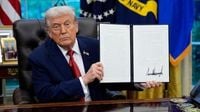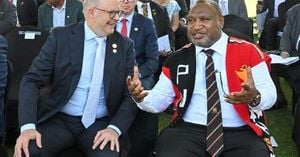In a move that has sent ripples through global markets and diplomatic circles alike, President Donald Trump signed an executive order on October 4, 2025, making TikTok a U.S. property after years of legal wrangling and political maneuvering. But beneath the headline-grabbing announcement lies a far more intricate tale—one that reveals how China may have carved out a significant strategic win, even as the U.S. claims victory.
The saga began years ago, with federal and state governments in the United States repeatedly attempting to restrict the Chinese-owned social media platform. The journey included court battles, legislative threats, and even a ruling by the U.S. Supreme Court. For a while, it seemed the fate of TikTok in America was sealed, with a ban or forced divestiture looming large. Yet, after four extensions of the legal deadline, Trump’s executive order instead transferred ownership to the U.S.—or so it appeared on the surface.
According to Ara, this “framework consensus” does not fully cut China out of the picture. In fact, it leaves Chinese authorities with considerable influence over TikTok, despite the optics of an American takeover. For those expecting a definitive end to the TikTok debate, the outcome is, at best, a mixed bag. What looks like a win for Washington could, in reality, be a masterstroke for Beijing and President Xi Jinping.
The TikTok deal was not forged in isolation. As reported by Bloomberg, it was the centerpiece of broader trade talks held in Madrid in September 2025, where U.S. and Chinese negotiators hammered out a framework to keep TikTok operating in the U.S. Despite persistent national security concerns from American lawmakers, the agreement was reached amid a flurry of proposals from China. These proposals included a bold request: that the U.S. roll back national-security restrictions on Chinese deals, and in return, China would dangle the prospect of a massive investment package—potentially worth $1 trillion.
Sources familiar with the negotiations told Bloomberg that Chinese negotiators also pressed for the U.S. to lower tariffs on imported components used by Chinese factories in America. The stakes were high, and the offers on the table represented a dramatic shift from the trade talks of Trump’s first term, which had focused primarily on Chinese purchases of U.S. goods rather than investment in American soil.
In the aftermath of the Madrid talks, U.S. Trade Representative Jamieson Greer told Fox Business that discussions had centered on “the investment climate in the United States for Chinese companies.” On the Chinese side, senior trade negotiator Li Chenggang told reporters, “The U.S. had expressed its willingness to move together with China toward the same goal when it comes to reducing barriers to investment and promoting relevant cooperation on [the] trade and economic front.”
President Xi Jinping himself entered the fray, urging Trump in a phone call in late September to “create conditions for Chinese enterprises to invest” in America. The message was clear: China wanted a seat at the table, and it was willing to offer significant incentives to get it.
Whether the Trump administration will ultimately accept China’s investment package remains an open question. One source told Bloomberg that the U.S. “hasn’t yet ruled anything out.” The size and structure of the potential investment are still up in the air, but the TikTok framework—where the U.S. takes control of a Chinese entity’s American operations—could serve as a template for future deals.
The numbers involved are staggering. Earlier this year, Chinese officials reportedly floated a $1 trillion investment figure. For context, the European Union has committed $600 billion in investment over the next four years, while Japan and South Korea are considering $550 billion and $350 billion, respectively. A $1 trillion pledge from Beijing would dwarf these commitments and mark a sharp reversal in the trajectory of Chinese investment in the U.S., which has slowed dramatically in recent years. After peaking at $57 billion in 2016, Chinese investment in the U.S. dropped to just $2.1 billion in the first half of 2025, according to Rhodium data cited by Bloomberg.
But the path forward is anything but smooth. Over the past decade, both Washington and Beijing have enacted policies to restrict cross-border investment, particularly in sensitive sectors like technology and infrastructure. The Committee on Foreign Investment in the U.S. (CFIUS) has been at the forefront, blocking Chinese deals on national security grounds. Notable cases include the forced sale of Grindr, the scuttling of Jack Ma’s fintech company’s bid for MoneyGram International, and the removal of a Chinese cryptocurrency mining firm from land near a U.S. military base. As recently as February, the prevailing mood in Washington was even more hawkish, with Trump issuing a presidential memorandum warning that “investment at all costs is not always in the national interest.” That memo accused China of using U.S. investments to obtain cutting-edge technologies and leverage in strategic sectors.
Yet, Trump has made attracting foreign investment a pillar of his second-term economic strategy. He has claimed $17 trillion in investment commitments since January 2025, and has repeatedly stated that his top priority with China is “frankly, more importantly, a big deal.” For China, gaining greater access to the world’s largest consumer market would be a lifeline, especially as domestic demand wanes and companies face pressure to cut prices and jobs.
Still, not everyone in Washington is convinced. Representative John Moolenaar, Republican chairman of the House Select Committee on China, warned, “China has weaponized its own market and companies against us for decades, and we cannot allow those companies to have more access to our economy.” Matt Pottinger, former deputy national security adviser and a well-known China hawk, was even more blunt: “That would be tantamount to the U.S. becoming part of the Belt and Road—indeed, its final destination.”
Despite these concerns, there are voices suggesting a more nuanced approach. Laila Khawaja, research director of Gavekal Technologies, told Bloomberg, “If the TikTok deal can go through, I think it could open up more space for the U.S. to consider allowing Chinese investments. We could see Chinese firms be asked to set up joint ventures with American firms while holding minority stakes and sell or license technologies to the ventures.”
There are also practical hurdles. A growing number of U.S. states have imposed their own restrictions on Chinese investment, adding another layer of complexity. And while Beijing has tightened its own capital controls in recent years, Chinese executives are eager to break into new markets, especially as export controls threaten some of their most innovative green technologies.
For now, the TikTok deal stands as a symbol of the new era in U.S.-China economic relations: fraught with suspicion, yet driven by mutual necessity. Whether this fragile framework will hold, or whether it will unravel under the weight of competing interests and political backlash, remains to be seen. But one thing is clear—neither side is ready to walk away from the table just yet.
As the dust settles, both Washington and Beijing are recalibrating their strategies. The TikTok saga, far from being a simple story of winners and losers, has become a case study in the art of negotiation—where every apparent concession may conceal a deeper play for influence and advantage.





